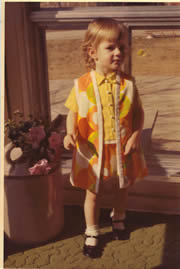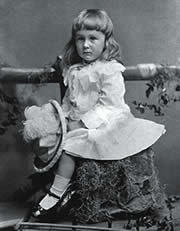
One of my favorite childhood photos is a fashion shot of me at about age 3. I’m standing on our pea-green carpeting, next to a jug of fake flowers, wearing an orange-and-yellow knock-off Pucci tunic vest. I’m hesitant to make eye contact with the camera, with a wary expression on my face that says, “I look like Bea Arthur. I will never forgive you for this.”
Sure, you could blame the ’70s. But when are parents going to step up and take some responsibility? Why don’t they just admit it? “When we dress our kids, we don’t always have their best interests at heart.”
I wasn’t the only fashion victim. Look closely at a photo of any small child dressed up in a sailor suit or reindeer antlers, and you’ll see an unmistakable message in their eyes:
“Help me.”
If you doubt it, visit awkwardfamilyphotos.com. You’ll get an eyeful. The category devoted to the ’80s is particularly enlightening.
Why the embarrassing clothes? Is this our way of punishing our kids for all the future misery they’re bound to bring us?
In the course of my anecdotal research, I’ve found that there are four distinct stages of dressing kids.
Stage one: We dress kids for a good laugh.

New parents are giddy with power. We have all the control — but deep down, we know this period is cruelly brief. So we assert our dominance while we can, before our babies can learn to crawl away from bad fashion choices.
In this first stage, we dress kids as peapods and gnomes for Halloween. We photograph them in flowerpots. We snicker as we put them in onesies that say “Does this diaper make my butt look big?” and “I only cry when ugly people hold me.”
There is a photo of future President Franklin Delano Roosevelt as a toddler, wearing a white frilly dress and patent Mary Janes, holding a hat with a marabou feather and pioneering a hairstyle that’s a cross between a bowl cut and a mullet. It’s proof that even the great ones can’t escape this widespread, socially approved fashion hazing.
If we truly respected our kids, we’d buy them comfortable black separates, with maybe a tasteful pacifier for a splash of color.
We would not — and I am guilty of this myself — dress them as poodles.
Above all, we would not excuse our behavior by insisting, “But it builds character!”
Stage two: We dress kids for identification purposes.
It goes without saying that we need to dress our children to stand out, or we’re likely to bring the wrong stroller home from Starbucks. All kids start out bald and drooling, after all. But if you pop yours into a leopard-print romper, there’s less chance of a tragic mix-up.
More common, though, is color-coding our kids. We dress them to match their siblings or sometimes the car upholstery. And we color-code them according to their gender.
Just recently, kids’ clothing giant Gymboree marketed onesies that said “Smart like Dad” and “Pretty like Mommy.” And JC Penney sold sweatshirts that said “I’m too pretty to do homework so my brother has to do it for me.”
Are we worried that we’ll accidentally play trucks with the girls and put tiaras on the boys? Or are we worried that the kids themselves will forget their gender?
Does it matter?
Whatever the motivation, we dress the girls in hyper-feminine tops that declare “Divalicious!,” while all boys’ clothes must be endorsed by a time-tested superhero or winning sports team.
The girls, confusingly, end up looking like overzealous drag queens, while the boys — well, the boys look exactly like they will in 20 years, when they are still living in our basements: under-bathed, in layers of sweats.
Stage three: We dress them better than ourselves.
When my son was born, among the usual gifts (receiving blankets, Peepee Teepees) was a set of heavenly blue Burberry pajamas.
For the baby!
I’m not ready to publicly confess that I was jealous. I will, though, share my first thought upon opening the box: “But he hasn’t earned them!”
Sadly, seven years later, I’m still waiting for my first item of Burberry clothing. And my son still hasn’t earned his.
Yes, of course we want our kids to have it better than we did. We want to give them the world. Designers have been taking advantage of this for years, making a bundle off teeny Oscar de la Renta frocks, Gucci hoodies, Dolce & Gabbana sneakers and Ed Hardy skull T-shirts that say “Love Kills Slowly” (just $24.95!).
I’ll say it. In my day, we wore mix-and-match Garanimals — and we liked it.
Time will tell if baby Ugg boots will warp these kids’ values. But if you want my opinion, when you get Burberry at birth, I can pretty much guarantee you that life is downhill from there.
Stage four: Kids strike back.

I don’t remember caring about what I wore until junior high, when I begged my mom for a pair of dark-wash, high-waisted Jordache jeans. (Timeless!) But my second grader already rejects whatever I pull out of the closet, saying, “I don’t want to look cute! That’s not my style.”
Her style, near as I can tell, is “materialistic hippie”: glittery, mass-marketed peace-sign T-shirts that are appropriate for all occasions.
Last year, a well-publicized study from Ohio’s Kenyon College concluded that almost a third of young girls’ clothing is sexualized. Well, sure, if you consider lace miniskirts to be oversexualized. They do go nicely, though, with the lower-back temporary tattoos (“tramp stamps”) girls can buy at Toys “R” Us.
We should probably be more worried about boys’ sartorial choices. Trend-setter Justin Bieber has been open about his preference for women’s slim-fit jeans, with the waist hitting just under the butt. I’m not sure if that’s categorized as oversexualized, but it is efficient: When it comes to de-pantsing, why not cut out the middle man?
And this is where we have to learn to let go. Just when it’s most painful to watch, we have to lovingly set our kids free. Like any good fashion fad, it all comes back full circle.
We may start out dressing them in embarrassing, clownlike clothes, but we make the most of the few years we can influence their wardrobes. We show them how to have fun with what they wear. We nurture their identities and build up their confidence. And it’s all for this:
So our kids can choose embarrassing, clownlike clothes on their own.
Paige Smoron Wiser is a writer for Michigan Avenue magazine and reviews movies as half of “Paige & Plummer” on ABC-7’s Windy City Live. She lives in Inverness, Illinois, with her husband and two stylish children.